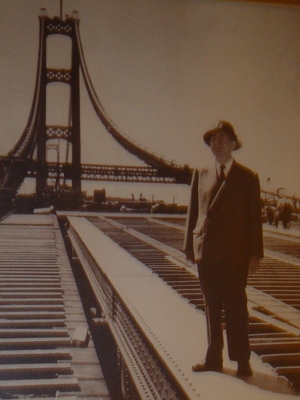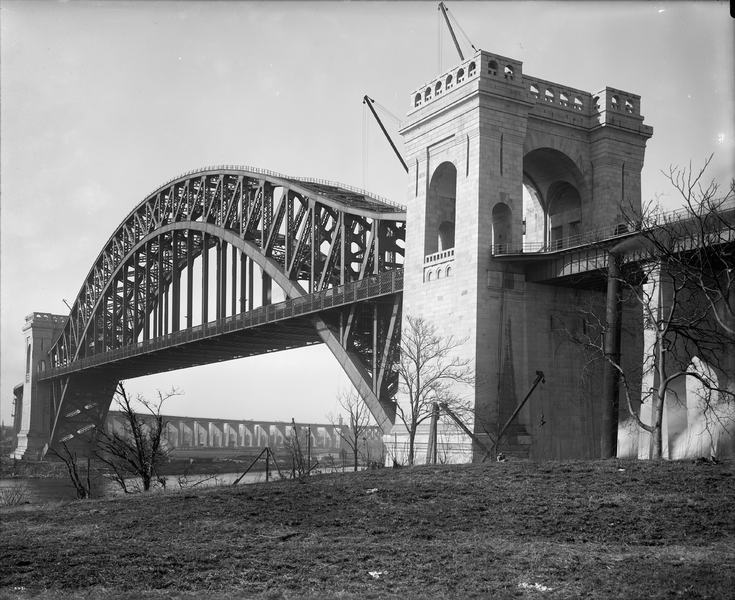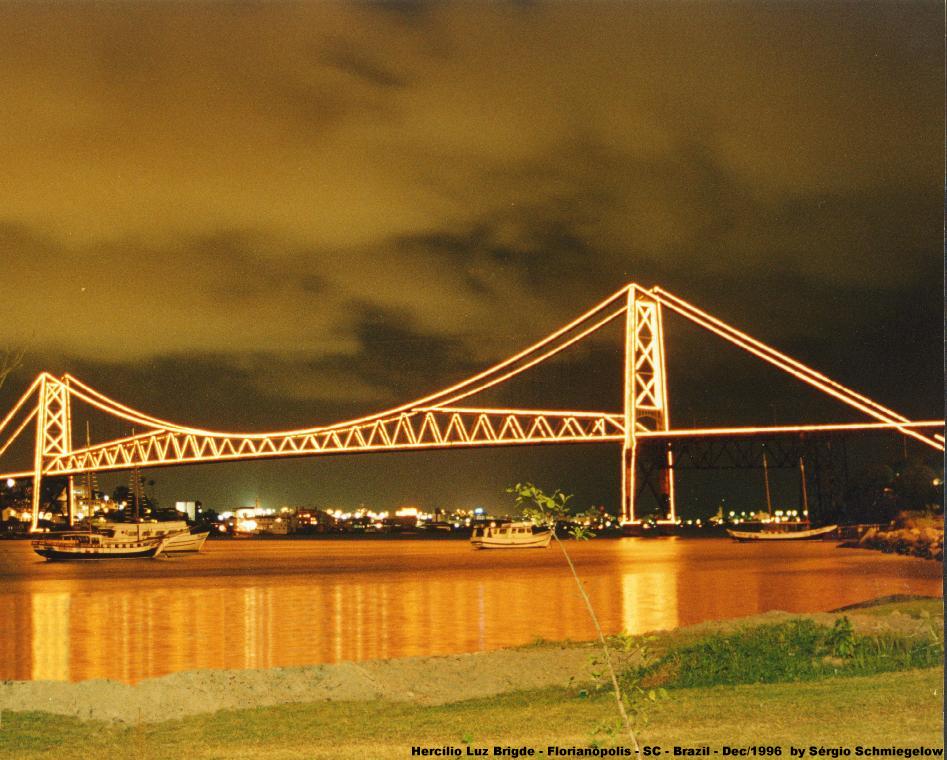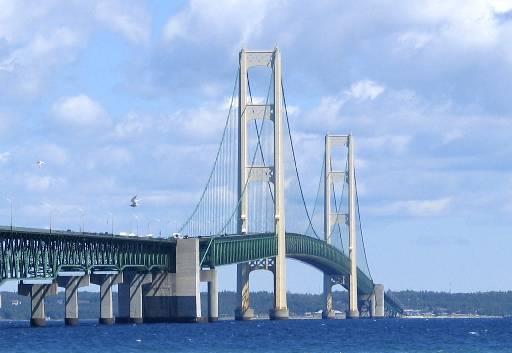<Back to Index>
- Engineer David Bernard Steinman, 1886
- Composer Richard Georg Strauss, 1864
- Member of Congress Jeannette Pickering Rankin, 1880

David Bernard Steinman (June 11, 1886 - August 21, 1960) was an American structural engineer. He was the designer of the Mackinac Bridge and many other notable bridges, and a published author. He grew up in New York City's lower Manhattan, and lived with the ambition of making his mark on the Brooklyn Bridge that he lived under. In 1909 he received a Master of Arts from Columbia University and a Doctorate in 1911.
David
Steinman built bridges in the United States, Thailand, England, Italy,
Haiti, Puerto Rico, Canada, Korea, and Iraq. He had a literary bent,
and was a published author with several books, articles in advancement
of his craft, and even had children's books and poetry to his credit. Steinman
was the child of immigrant workers. Little is known of his family and
early childhood other than that he had 6 siblings. There is some
controversy about where and when he was born. Some sources have him born in Khomsk, Brest, Belarus in 1886, and emigrating to the United States with his family in 1890. However other sources, including Ratigan, and Steinman himself have him born in New York in 1887. Steinman grew up in New York City, New York, and was raised in the shadows of the Brooklyn Bridge. The Williamsburg Bridge was
constructed as he grew up. The late Nineteenth and early Twentieth
centuries were a time of significant bridge construction in the area,
and he later said this is where he got his first interest in bridges. Because his family had little money, he worked to put himself through both the City College of New York, graduating Summa Cum Laude in 1906 and then Columbia University, where he completed three additional degrees culminating in a PhD in Civil Engineering. His PhD thesis was on a steel truss arch design for the Henry Hudson Bridge. While he was attending Columbia he did fellowships as well as taught nighttime classes at the City College and Stuyvesant Evening High School. He accepted a teaching position at the University of Idaho in Moscow, Idaho (1910-1914) but longed to return to New York.
After contacting Gustav Lindenthal about working on the Hell Gate Bridge, he returned to New York City to become a special assistant to Lindenthal, along with Othmar Ammannof
Switzerland, another young bridge builder. It was said this experience
of working together led to their 40-year professional rivalry. Pay was
typical for the era, 200-225 USD/month. Lindethal gave his proteges
advice about engineering such as, “Steinman, bridge engineering is
easy. It is the financial engineering that is hard”.
While working with Lindenthal, Steinman also worked on the Sciotoville Bridge, a crossing of the Ohio River. After this work Steinman sought other employment, working as assistant engineer on the Rondout Creek Bridge, and as an assistant engineer for the New York Central Railroad. In May 1920, Holton D. Robinson (b. 1863, Massena, NY, d. 1945, engineer of the Williamsburg Bridge) contacted Steinman and requested that they join forces to create a design for the Florianópolis Bridge (or Hercilio Luz Bridge, 1926) in Florianópolis, Brazil. After getting advice from Charles Fowler, Steinman agreed and they formed the firm of Robinson & Steinman in
1921, a partnership that lasted until the 1940s. They did not win the
contract immediately but continued to collaborate on it and other
projects. The early 1920s were considered a tough time for bridge
construction, so Steinman tried to design his bridges to be
economically pleasing rather than artistic, without sacrificing the
structural integrity of the bridge. For example, Robinson and Steinman
changed the original plans for the Florianopolis bridge, using eyebar
chains as the upper chord of the stiffening truss instead of the
conventional wire-cable. The new design produced a very stiff bridge
with much less material than the original plan. Other bridge engineers
would also have to take this new economical design into account when
competing with Steinman. Steinman was well regarded in the profession
and had a reputation for good presentations and for being politically
astute. The 1920s and 1930s were a relatively busy period for Steinman. His firm was involved in many significant projects including the Hercilio Luz Bridge (or Florianópolis Bridge, 1926), the Carquinez Strait Bridge (1927, at the time the second largest cantilever bridge in the US), the Mount Hope Bridge and Grand Mère Suspension Bridge (both 1929), the St. John's Bridge and Waldo-Hancock Bridge (both 1931), the Sky Ride (1933 passenger transporter bridge at the Chicago Century of Progress exposition), the Henry Hudson Bridge (1936, particularly gratifying as this bridge realised his PhD thesis proposal), the Wellesley and Hill Islands Bridge, Wellesley Island Suspension Bridge and Georgina Island Bridge (all 1938) and Deer Isle Bridge and the Sullivan-Hutsonville Bridge (both 1939) (many of these are part of the Thousand Islands Bridge System). In
addition to the many bridges that Steinman designed, he was consulted
on several projects that his firm did not win. Perhaps the most famous
of these bridges is "Galloping Gertie", the original Tacoma Narrows Bridge.
Steinman consulted extensively with the boosters of the bridge during
the 1920s, but his design was not selected. He wrote of his frustration
with the design that was chosen, and predicted a failure. He presented
his findings at the 1938 meeting of the structural division of the
American Society of Civil Engineers. In the audience was the designer
of the Tacoma Narrows Bridge, which was under construction at the time.
The failure did occur and he wrote that it had a profound impact on his
design principles; he became even more conservative. It is said that he
designed the Mackinac Bridge considered
by many to be his most significant work (although, perhaps not by
Steinman himself, who expressed a personal preference for the St. Johns
bridge, saying, "If you asked me which of the bridges I love best, I
believe I would say the St. Johns bridge. I put more of myself into
that bridge than any other bridge."), to withstand winds of 365 mph. During this period Steinman became president of the American Association of Engineers and campaigned for more stringent educational and ethical standards within the profession. He also founded the National Society of Professional Engineers in
1934 serving as its first president. By the mid 1930s Steinman had a
professional reputation as one of the pre-eminent bridge engineers of
the US, especially for long span suspension bridges, but his bridges
were eclipsed in the public eye by his old rival Ammann's George Washington Bridge (1931) and by Joseph Strauss's Golden Gate Bridge (1937)
among others. His plans for a NYC cross harbor bridge (the "Liberty
Bridge") came to naught with the 1940 collapse of Tacoma Narrows which
cast all long suspension span proposals in doubt. Steinman and his firm were also in charge of the major rehabilitation of the Brooklyn Bridge commencing 1948. Structurae.de has an image of Steinman jauntily perched in mid air in the cables
of the bridge, perhaps one of the best known images of him extant. But there were still long span suspension bridges to be built. Steinman was responsible for the Kingston-Rhinecliff Bridge (1957). More importantly, development and planning of the Mackinac Bridge had been contemplated for some time, and Steinman was appointed to the board of engineers based on Michigan State Legislature legislation
of 1950, stating "the board of engineers retained by the Mackinac
Bridge Authority was to be selected and nominated by the Dean of
Engineering at the University of Michigan", and was soon the spokesman
for the board. But his health was failing and he suffered heart attacks
in 1952, the same year the legistlature approved funding. He was
nevertheless heavily involved in all aspects of the construction of the
bridge from start to finish. Although he proposed a grandiose 1524 meter center span crossing of the Sicilian Straits of Messina,
the "Mighty Mac", completed in 1957, and at the time the longest
suspended span between anchors, was his last major achievement.
Steinman died in 1960. At the time of his death, he was president of
the Society for the History of Technology. The Steinman engineering firm is now part of the Parsons Transportation Group as of 1988.
At
the age of 63, Steinman took interest in poetry. Many people wrote to
him saying his bridges represented poems. This inspired him to start
writing. His love for bridge building was reflected in his writing,
which can be seen in the titles of two of his poems, “The Bridge” and
“I Built a Bridge”. He received much recognition for his poetry; many
poems were published in various newspapers and magazines. Continuing
his natural ability to lead, Steinman became involved in leadership
roles in many poetry groups including the president of the Wisconsin Poetry Foundation and director of the Poetry Institute in New York.


